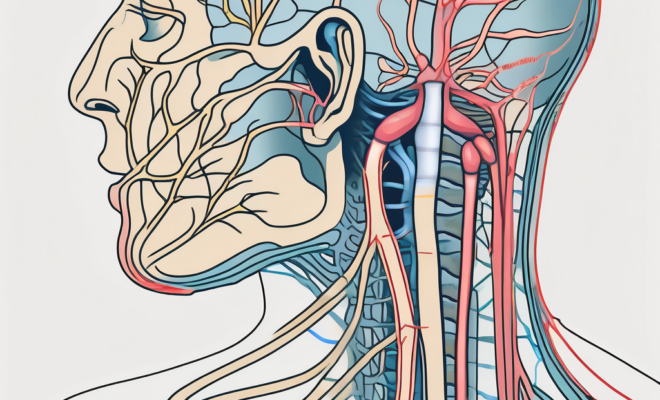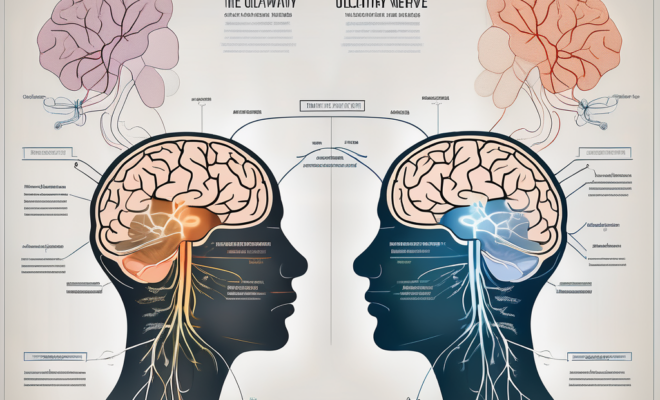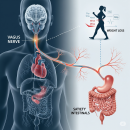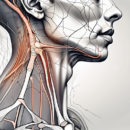The Role of the Glossopharyngeal Nerve in the Human Body

The glossopharyngeal nerve is a crucial component of the human nervous system, playing a multifaceted role in various bodily functions. Understanding the intricacies of this nerve is essential for medical professionals and researchers alike. In this article, we will delve into the anatomy, functions, interactions, disorders, diagnosis, treatment, and future research of the glossopharyngeal nerve.
Understanding the Glossopharyngeal Nerve
Anatomy of the Glossopharyngeal Nerve
The glossopharyngeal nerve, also known as the ninth cranial nerve, originates from the medulla oblongata in the brainstem. It extends downwards through the jugular foramen and branches out to innervate various structures, including the middle ear, pharynx, tongue, and baroreceptors in the carotid sinus.
This intricate network of fibers allows the glossopharyngeal nerve to facilitate crucial sensory and motor functions.
The glossopharyngeal nerve is a mixed nerve, meaning it contains both sensory and motor fibers. The sensory fibers of the glossopharyngeal nerve carry information from the posterior one-third of the tongue, the tonsils, the pharynx, and the middle ear. These sensory inputs are essential for functions such as taste perception, swallowing, and monitoring blood pressure.
Functions of the Glossopharyngeal Nerve
The glossopharyngeal nerve has both sensory and motor functions that contribute to several vital bodily processes. It serves as a conduit for taste information from the posterior one-third of the tongue. Additionally, it plays a role in swallowing, salivation, and sensory input from the pharynx and middle ear.
Moreover, the glossopharyngeal nerve is involved in the regulation of blood pressure through its interactions with the carotid sinus. Baroreceptors in the carotid sinus transmit signals regarding blood pressure to the brain via the glossopharyngeal nerve, allowing for appropriate cardiovascular responses.
In addition to its sensory functions, the glossopharyngeal nerve also has motor functions. These motor fibers are responsible for controlling the stylopharyngeus muscle, which plays a role in swallowing and speech. The glossopharyngeal nerve’s motor component is crucial for coordinating the complex movements involved in these processes.
The Glossopharyngeal Nerve and the Nervous System
Connection with the Central Nervous System
The glossopharyngeal nerve, also known as cranial nerve IX, plays a crucial role in connecting the peripheral nervous system to the central nervous system. This nerve is responsible for transmitting sensory information from the back of the throat, tonsils, and the middle ear to the brainstem. Once the sensory signals reach the brainstem, they are relayed to higher brain regions for processing and interpretation.
In addition to its sensory functions, the glossopharyngeal nerve is involved in various motor functions, such as helping to regulate swallowing and speech. This intricate coordination is made possible by the nerve’s extensive neural connections within the central nervous system.
Furthermore, the glossopharyngeal nerve’s connections extend beyond basic motor and sensory functions. It forms intricate pathways with brain regions like the hypothalamus and amygdala, contributing to the regulation of autonomic responses and emotional processing. These connections highlight the nerve’s role in not just physical functions but also in emotional and instinctual behaviors.
Interaction with Other Cranial Nerves
Interactions between the glossopharyngeal nerve and other cranial nerves are essential for ensuring the seamless operation of various bodily processes. One significant collaboration is with the facial nerve (cranial nerve VII), which controls facial expressions and taste sensation. The glossopharyngeal nerve works in tandem with the facial nerve to relay taste information from the back of the tongue to the brain, allowing for the perception of different flavors.
Additionally, the glossopharyngeal nerve interacts with the trigeminal nerve (cranial nerve V) to facilitate sensations related to the middle ear, such as pain and pressure. This collaboration ensures that sensory information from the ear is accurately transmitted to the brain for appropriate processing and response.
These intricate interactions among cranial nerves underscore the complexity and interdependence of the nervous system in carrying out essential physiological functions. The seamless coordination between these nerves is vital for maintaining sensory perception, motor control, and overall homeostasis within the body.
Disorders Related to the Glossopharyngeal Nerve
Glossopharyngeal Neuralgia
Glossopharyngeal neuralgia is a rare disorder characterized by recurrent episodes of severe pain in the areas innervated by the glossopharyngeal nerve. The exact cause of this condition is often unknown, but it can be triggered by various factors such as swallowing, speaking, or even touching the affected areas.
Individuals experiencing glossopharyngeal neuralgia may describe the pain as sharp, stabbing, or burning, often radiating to the ear, throat, and jaw. The intensity of the pain can be debilitating, impacting daily activities and quality of life. Diagnosis typically involves a thorough medical history, neurological examination, and imaging studies to rule out other potential causes of the symptoms.
While glossopharyngeal neuralgia is challenging to diagnose and treat, medical advancements continue to enhance our understanding and management of this debilitating condition.
Damage and Its Effects
Injury or damage to the glossopharyngeal nerve can result in various symptoms depending on the affected fibers. Such damage can lead to difficulties with swallowing, alterations in taste perception, impaired salivation, and even compromised blood pressure regulation in severe cases.
Patients with glossopharyngeal nerve damage may also experience referred pain in the ear, throat, or tongue, making it crucial to differentiate these symptoms from other conditions that may present similarly. Treatment options for glossopharyngeal nerve damage may include physical therapy, medication management, and in some cases, surgical intervention to address the underlying cause.
Identifying and addressing glossopharyngeal nerve damage is pivotal in maintaining optimal bodily functions and preventing further complications.
Diagnosis and Treatment of Glossopharyngeal Nerve Disorders
When it comes to diagnosing glossopharyngeal nerve disorders, healthcare professionals employ a multifaceted approach that delves deep into the patient’s medical history. This comprehensive evaluation is crucial in understanding the onset and progression of symptoms, as well as identifying any potential risk factors that may contribute to the disorder.
In addition to a detailed medical history review, a thorough physical examination is conducted to assess the patient’s overall health and to pinpoint any physical signs that may be indicative of glossopharyngeal nerve dysfunction. Specialized tests, such as swallowing studies and sensory assessments, are also commonly used to gather more specific information about the nature and severity of the disorder.
Advanced imaging techniques, including magnetic resonance imaging (MRI), are often employed to provide detailed images of the glossopharyngeal nerve and its surrounding structures. These imaging studies play a crucial role in identifying any structural abnormalities or lesions that may be affecting the nerve’s function.
Electrophysiological studies, such as nerve conduction tests and electromyography, are valuable tools in assessing the electrical activity and conduction of the glossopharyngeal nerve. By measuring the nerve’s response to electrical stimuli, healthcare providers can gain valuable insights into the nerve’s functioning and identify any areas of dysfunction.
Treatment Options and Rehabilitation
Managing glossopharyngeal nerve disorders involves a combination of treatment modalities aimed at addressing the underlying cause of the disorder and alleviating associated symptoms. Medications, such as antiepileptic drugs and tricyclic antidepressants, are commonly prescribed to help manage pain and stabilize neural activity in patients with glossopharyngeal neuralgia.
In cases where conservative treatments are ineffective, surgical interventions may be recommended to relieve compression on the glossopharyngeal nerve or repair any damaged nerve fibers. Surgical procedures, such as microvascular decompression or nerve grafting, aim to alleviate pressure on the nerve and restore its normal function.
Rehabilitation plays a crucial role in helping patients regain optimal swallowing and speech functions following treatment for glossopharyngeal nerve disorders. Speech therapy, swallowing exercises, and other rehabilitation techniques are tailored to address specific deficits and improve overall quality of life for patients recovering from glossopharyngeal nerve dysfunction.
The Future of Glossopharyngeal Nerve Research
Current Research Trends
As scientific knowledge and technological advancements continue to progress, ongoing research endeavors are expanding our understanding of the glossopharyngeal nerve’s role in the human body. Investigations into the neural pathways, molecular mechanisms, and neural plasticity associated with this nerve offer promising avenues for further exploration.
The glossopharyngeal nerve, also known as cranial nerve IX, is a crucial component of the human nervous system. It plays a vital role in various functions, including taste sensation at the back of the tongue, swallowing, and monitoring blood pressure. Recent studies have delved into the intricate connections between the glossopharyngeal nerve and other cranial nerves, shedding light on its complex interactions within the body.
Potential Breakthroughs and Innovations
The future of glossopharyngeal nerve research holds the potential for breakthroughs in diagnosing and treating associated disorders. Advancements in neuroimaging techniques, such as functional magnetic resonance imaging (fMRI) and diffusion tensor imaging (DTI), are providing researchers with unprecedented insights into the structural and functional connectivity of the glossopharyngeal nerve.
Furthermore, emerging therapies, such as neuromodulation techniques and gene therapies, show promise in targeting specific neural pathways associated with glossopharyngeal nerve dysfunction. These innovative approaches have the potential to transform the landscape of treatment options for individuals suffering from glossopharyngeal nerve-related conditions.
By increasing scientific collaboration and investing in research, we can unlock the full potential of the glossopharyngeal nerve and enhance our understanding and treatment of the intricate workings of the human body.















